Prun.exe
Prun.exe is a malicious program from the Trojan Horse category that has been created with criminal intentions. Once in the system, Prun.exe is capable of spying on its victims, stealing personal data, and destroying digital files without the users’ knowledge.

In the following article, you can find important information about Prun.exe and the potential complications which may come because of this infection. You will also find a helpful removal guide at the end of the page that contains the exact steps that you need to repeat to remove Prun.exe from your system.
In terms of computing and programming, any malware used to sneak itself and possibly another virus (such as a Ransomware, a Worm, a Spyware, etc.) in any system can be considered as a Trojan Horse. Typically, the Trojan Horse infections are often used by cybercriminals to stealthily hack a given computer (or a network of computers) and to perform different malicious tasks on it without the users’ knowledge. Most Trojan-based infections attack their victims quietly without visible alerts or hints. Users should also be aware of the fact that the Trojan viruses are the most common form of malware on the Internet and the chance of landing a threat like Prun.exe while browsing the web is greater than the chance of landing any other type of virus.
How can Prun.exe infect you?
A Trojan such as Prun.exe can infect you if you happen to interact with cracked software installers, infected email messages and their attachments, low-quality web pages that spread shareware or torrents, and even different links and ads that contain the malware. Besides, this threat can easily use any existing security holes on your system, such as any outdated software, the absence of an anti-malware program or a Firewall to sneak inside the computer without being detected and to perform the criminal deed it has been programmed for. Sadly, no one can tell you what to expect from a threat like Prun.exe because the Trojan is a multifunctional cyber threat that could be used for multiple illegal activities.
Theft of personal details, bank account credentials, passwords, and login details can probably top the list of potential malicious uses. However, a Trojan could be programmed to copy all your system data and transmit it to remove criminal servers. It can also be set to register all your keystrokes and even capture screenshots from your screen in order to provide its criminal creators with data that can help them perform other crimes.
The presence of infection like Prun.exe or Wup.exe on your system can be extremely dangerous also because this Trojan might actually spy on you through your own web camera and microphone and capture embarrassing videos and audios. This can help the criminals who stay behind the infection to begin abusing you, blackmailing you or threatening you because they have your personal information, including where you stay, what you are doing, where you are employed, etc. And to top it all, a Trojan can serve as a backdoor to other viruses and malware such as Ransomware and help them get delivered to your system without any symptoms.
How can Prun.exe be removed?
Our removal guide below contains detailed steps on how to remove Prun.exe from your system. To ensure the successful elimination of the infection, please read all the instructions closely and use a professional removal tool to double-check your computer.
SUMMARY:
How to Remove the Prun.exe virus
To remove the Prun.exe virus, you must find any rogue programs on your PC, uninstall them, quit any suspicious processes in the Task Manager, and revoke settings changes made by the Trojan.
- To start off, open Control Panel > Uninstall a Program, look for programs that look harmful or that haven’t been installed by you and uninstall them.
- Next, open the Task Manager, search its Processes tab for rogue items, and quit any suspicious processes you may find there.
- Thirdly, check the Hosts file and the Startup items on your PC and reverse any changes made to them by the malware in order to remove Prun.exe.
- Lastly, find and delete malicious items in the system Registry and then restart the computer. If the Trojan is still there, consider the use of a professional anti-malware tool.
Those steps will hopefully help you get rid of the malware. If you need a more detailed description of how to perform them, you will find further instructions down below.
Extended Guide
Some of the steps from the guide require a system restart so, to make finding the current page easier, we suggest bookmarking it in your browser. You can also open it on your smartphone or another device to look at the guide from there while performing the steps on your.
Step 1
To complete the first step, click the Start Menu icon in the bottom-left, open Control Panel, and click the button labelled Uninstall a Program.
This will take you to a list filled with all the programs currently installed on the computer. Look at the dates of installation looking for suspicious entries that have been added to the system not long before you first started noticing the Prun.exe symptoms. If there are any such programs installed around that time that seem questionable, and you think could be related to the Trojan, select their entries from the list and then select the Uninstall from the top.
Proceed with following whatever uninstallation steps appear on your screen and make sure that everything related to the program gets deleted. If the uninstaller offers to keep some data related to the unwanted program on your computer, refuse that offer.
It is suggested that you restart the PC before you go to the next step.
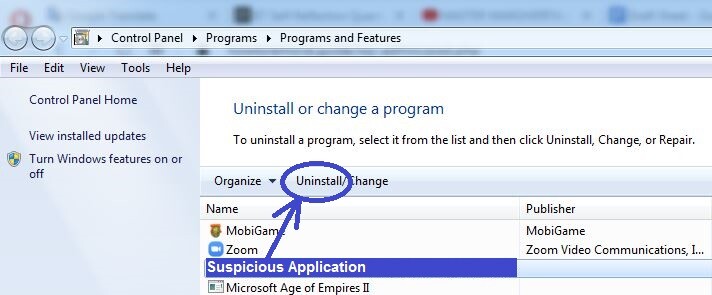
Step 2
WARNING! READ CAREFULLY BEFORE PROCEEDING!
Evoke the Task Manager by pressing the following keys from your keyboard: Ctrl + Shift + Esc.
When the Task Manager utility appears, go to the Processes section and look at what processes are listed there. Usually, the one or ones related to the virus would have high RAM and CPU consumption and may have an unusual or unfamiliar name. Another possibility is if the name of the malicious process is similar to the name of a program that you know but with one or two letters changed or added so that the name isn’t exactly the same.
Use your own judgement to figure out which processes may be malicious. If a given entry seems like a potential threat, use a reputable search engine to find more information about it. Look up the process name and see what other users or security researchers have posted about it.
If you find information from a legitimate source that says the process may be harmful, return to the Task Manager, right-click the process in question, and select Open File Location. Whatever files are in that folder, scan them with the online scanner we’ve included below:

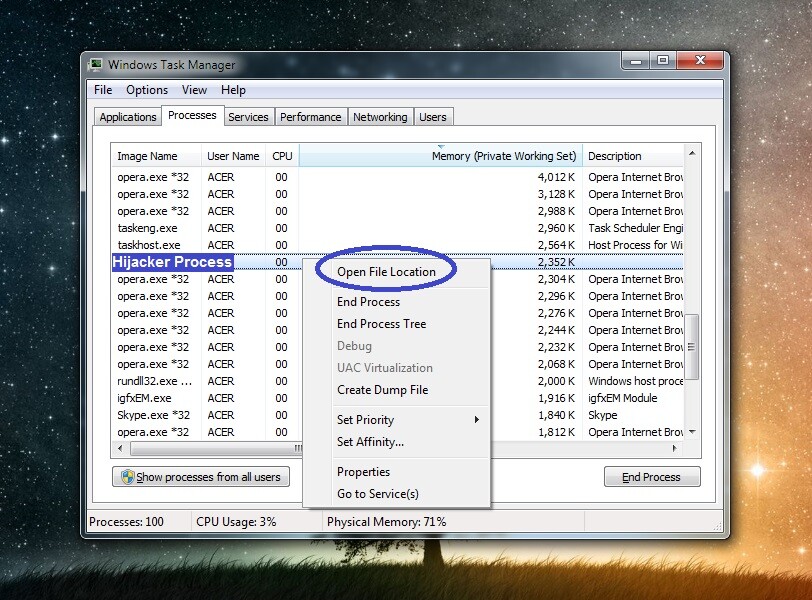
In case any of the files are flagged as threats, delete all of them and then delete the folder they are contained in. After that, go to the process, right-click it, and select the End Process option.
If you are prohibited from deleting any of the files, leave them for now and go to the next step. When you complete the Prun.exe removal guide, try to delete the file location folder of the malicious process one more time.
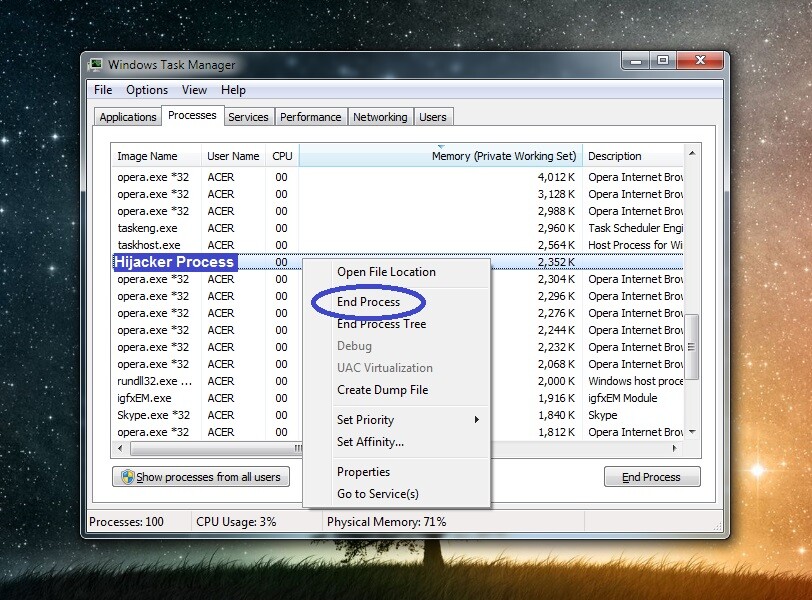
Important!: In case none of the files in the file location folder are detected as threats, but you have a strong reason to believe the suspected process is harmful based on the information you’ve found about it online, you should still delete its file location and then quit the process.
Step 3
Put your PC into Safe Mode – this will keep any remaining malware processes from disrupting you during the next steps. Follow the link for more information on how to boot into Safe Mode for different versions of Windows.
Step 4
Press and hold the Winkey and then press R – when the Run window appears, copy-paste the next line in it and then click OK: notepad %windir%/system32/Drivers/etc/hosts.
When a notepad file named Hosts opens, look what’s written at the end of the text – if you see any IPs written after Localhost, this means that the file has been manipulated, probably by the Trojan. However, to be sure, we need to take a look at the IPs so copy-paste them in the comments below, and we will tell you in a reply to your comment if further action is required, regarding them.

Go to Run again, type msconfig in it, and select the OK button.
Open Startup from the top in the System Configuration window and see what items are shown in the list. Anything with an unknown manufacturer and/or that looks like it could be from the virus you should uncheck and then click on OK to apply and save the made changes to the System Configuration.
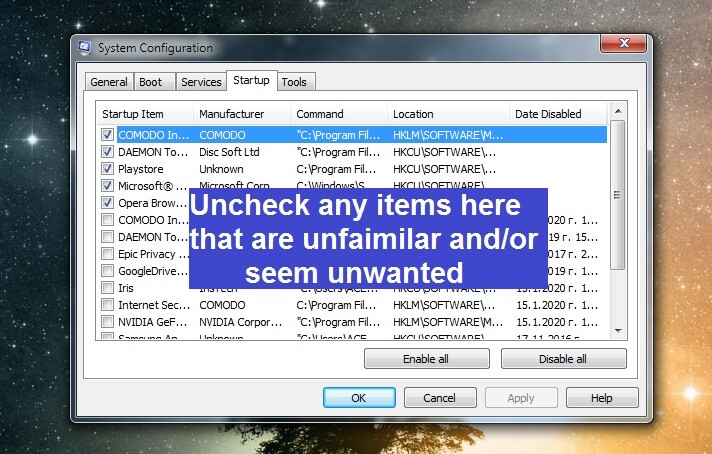
Go to Run once more, type ncpa.cpl in the search field, click OK, and find and right-click the icon of whichever network is currently in use by your PC.
Select the Properties button from the menu, click the Internet Protocol Version 4 entry, and select the next Properties button.
Enable (if it is currently not enabled) the Obtain an IP address automatically setting and then click on Advanced. In the Advanced window, select the DNS section and delete any IPs that you may find listed there.
Lastly, to complete the step, remember to save all made changes by clicking OK on everything.
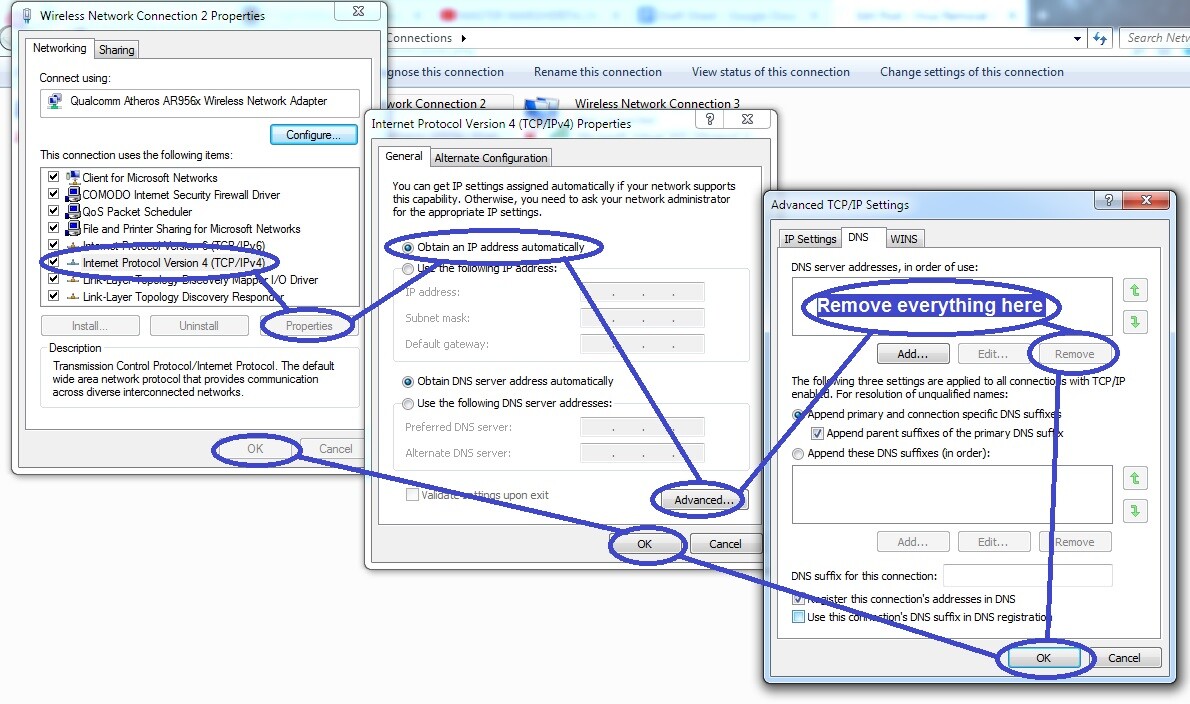
Step 5
Important!: While deleting Registry items in this step, always make sure that what you are deleting is related to Prun.exe. Otherwise, if an item that shouldn’t be deleted is removed, this could result in system problems. Therefore, we suggest asking us in the comments whenever you aren’t sure about whether a given Registry item needs to be deleted.
Start the Registry Editor by going to the Start menu, typing regedit, clicking the regedit.exe icon from the results, and clicking Yes from the dialogue window that pops-up.
Once in the Editor, you must select the menu labelled Edit (form the top) and click the Find option. In the search field, you must type Prun.exe and then click Find Next to search for related items. If you find an item, delete it, search for the next one, delete it as well, and keep doing this over and over again until all Prun.exe items are deleted from the Registry.

After that, go to each of the next three locations by expanding the folders to the left:
- HKEY_CURRENT_USER/Software/Random Directory.
- HKEY_CURRENT_USER/Software/Microsoft/Windows/CurrentVersion/Run
- HKEY_CURRENT_USER/Software/Microsoft/Internet Explorer/Main
Once you navigate to each of them, look for subfolders in them that are with unusually long names and/or the names of which consist of randomized strings of characters. If you encounter such a subfolder, delete it. If you are uncertain whether a given subfolder is unwanted, ask about it in the comments.
Step 6
In case you are still having problems with Prun.exe after completing the manual removal steps, it probably means that the malware has nested itself deep inside your system and professional help may be required to eliminate all of its components. For that reason, we believe that using the specialized anti-malware tool found on this page could be a good solution in such cases – the program is tested against threats of this caliber and can quickly locate and take care of Prun.exe, securing your PC.

Leave a Reply